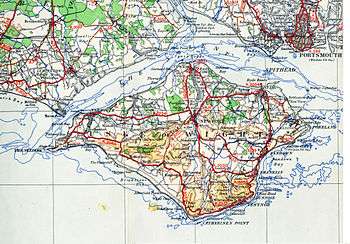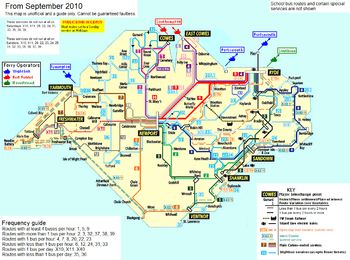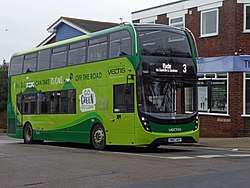Transport on the Isle of Wight


Rail

The Island Line is the one railway left on the island. It runs some 8½ miles from Ryde Pier Head to Shanklin, down the eastern side of the island via Brading and Sandown. It was opened by the Isle of Wight Railway in 1864, and between 1996 and 2007 was run by the smallest train operating company on the National Rail network. Services are now provided by Island Line Trains, part of the South West Trains franchise, using electric trains which are old London Underground rolling stock.
The island also has a steam-operated heritage railway, the Isle of Wight Steam Railway. This connects with the Island Line at Smallbrook Junction, and was part of the former Ryde to Newport line.
In the 1950s and 1960s, and before the Beeching Report, the island enjoyed a comprehensive network based on a triangle of lines connecting Ryde, Newport, Sandown and Ventnor. Lines ran from Ryde to Cowes via Newport and from Ryde to Ventnor via Brading, Sandown and Shanklin. Branch lines led from Brading to Bembridge, Sandown to Newport and west from Newport to Yarmouth and Freshwater. There were 2 stations at Ventnor:
- Ventnor, the terminus of the aforementioned Island Line from Ryde via Brading, Sandown and Shanklin.
- Ventnor Town (renamed Ventnor West by the Southern Railway in 1923) – a branch of the Newport-Sandown line from Merstone, via Godshill.
The two lines terminated at different levels above the town.
Today much of the old rail network has been converted to cycle ways, including the Newport-Cowes, Newport-Sandown and Yarmouth-Freshwater sections. Other sections can still be traced on the ground, including the two tunnels where the Ventnor lines ran beneath the downs.
Roads
The Island has 489 miles (787 km) of roadway, and does not have any motorway, although it does have a short stretch of dual carriageway with a 70 mph speed limit north of Newport.
A sign used to greet visitors disembarking from the car ferry at Fishbourne stating Island Roads are Different, Please Drive Carefully.[1]
Buses

April 1905 saw the start of bus services, with the Isle of Wight Express Syndicate operating a circular service running between Newport, Shanklin, Sandown and Ryde. The Vectis bus company was formed in 1922. At first it used only double decker buses; however a review found that island roads were not always suitable, and so single deckers were used instead (double deckers were re-introduced in 1936). In 1929, the Vectis Bus Company was bought by Southern Railway, forming Southern Vectis. After 1968 it became part of the state-owned National Bus Company. In 1986 with privatisation, the bus company was bought by its management team, and it stayed independent until 2005, when it was bought by the Go-Ahead Group.[2]
Southern Vectis had a near-monopoly of island bus transport for most of the 20th and early 21st Century, challenged only briefly after deregulation in 1986. It now runs fifteen different routes, with the most regular services between the larger towns such as Ryde and Cowes. From April 2006, the company changed the livery on its buses (excluding open top buses) to two shades of green, and also adopted a new simplified network, based on most routes radiating from Newport. The bus station in Newport was relocated nearby and redeveloped, with the previous site built over with shops.
During the summer, Southern Vectis also operates some open-topped buses as tourist routes: The Downs Breezer and The Needles Breezer.
Wightbus first started in the 1970s as the Isle of Wight County Council's 'County Bus', and branded 'Wightbus' in 1997. They operate a smaller network of services that are not viable for a commercial operator, but that attract government subsidy. They took around 1000 island students to and from school, until Southern Vectis took over all school services from September 2010.[3]
Cowes has currently the only park-and-ride bus site on the island; however there has been talk of building one for Newport.[4]
Bus stations
There are three bus stations on the Isle of Wight, most services from them are run by Southern Vectis:
Newport
Newport bus station is located in Newport town centre of Newport, on Orchard Street. The old bus station was demolished in late 2005 to make way for a retail development.[5]
The bus station features an indoor heated waiting area and an information desk. Seats and lighting have been installed and the entire bus station is a no-smoking area.
Newport town centre has bus lanes leading to the bus station, known as the 'Red Carpet'. However one section of the bus lane in South Street, close to the bus station, which was originally temporary while the bus station was being built, has been proved 'not legal', effectively meaning any other vehicle can use it.[6]
Ryde
Ryde bus station is slightly smaller than Newport's and is located on the esplanade near the Hovertravel terminal and Island line railway station. There are plans to re-develop it into a new interchange as a gateway to the island; however, these have been subject to delay. Benches and litter bins removed for construction work have been replaced and the temporary Esplanade bus stops removed. In October 2009 the project was abandoned.[7]
Yarmouth
Yarmouth bus station, next to the Wightlink ferry terminal, serves Southern Vectis route 7 as well as The Needles tour during the summer. As well as three stands for buses, the area has parking for visiting coaches, often full in the summer. There is a large bus shelter for waiting passengers, which doubles as an information kiosk in the summer.
Walking and cycling
The Island has an extensive network of byways, bridleways, footpaths and cycle tracks, including 520 miles (840 km) of public rights of way. Several long distance paths are highlighted on Ordnance Survey maps and local signs, including a route around the whole island (the Isle of Wight Coastal Path), and smaller trails such as the Tennyson Trail and Worsley Trail. The island is also home to the Isle of Wight Walking Festival, which has taken place annually in May for ten years and now has over 200 different walks.[8]
Sustrans National Cycle Network routes 22 and 23 have sections through the Isle of Wight, including off-road sections of route 23 between Cowes and Newport and Newport and Sandown along disused railway lines. There is a signed "round-the-island" cycle route primarily on road, as well as a 12-mile (19 km) on and off-road leisure route called the Sunshine Trail. The Island holds an annual Cycling Festival in July and the Isle of Wight Randonnee takes place on the May Bank holiday, a cycling race going over minor roads right around the island.
Air
There are two small general aviation airfields : Isle of Wight Airport at Sandown and Bembridge Airport. These are popular with day-trippers flying from the mainland in summer. Flights to and from London have been trialled, but proved unpopular and were discontinued.[9] However future plans could see the flight reinstated.[10]
Fixed link proposals
Over the years a fixed link (by tunnel or bridge) has often been discussed. All schemes have traditionally been opposed by many island residents and tourists.
In 2017, campaigners for a fixed link claimed that public opinion had shifted in favour of a fixed link, and based on a poll of residents in which 3280 people supported the idea. However, that represented only 3% of the island's population. [11].
The arguments for a fixed link include unproven claims that it would boost the economy by creating more jobs and by providing faster, cheaper and less weather-dependent travel to the mainland. Conversely, the arguments against include a potential reduction in jobs and services if roles were to be outsourced to the mainland, negative environmental impact (such as on the red squirrel population), increases in traffic putting stress on the local road network, the loss of the island's character and thus a decline in tourism, a potential increase in crime and upward pressure on house prices.
Additionally, there is concern that it might affect the pace of life on the island and make ferry services commercially unstable, and thus reducing the choice of routes to reach the mainland.
Among the schemes suggested was one in March 2008 for a proposed tramway to link Ryde to Gosport and rail networks on both sides. The plans also included a large new harbour at Ryde, with berthing facilities for four car and four passenger ferries and two container ships and replacement facilities for the harbour.[12] Unlike previous proposals, it was met with more support from residents, as it would not risk increased volumes of traffic on the island's roads.[13] To date (2016) little more has been heard of this proposal.
In late 2014, a new IOW Fixed Link Campaign, and organised by Prowling, emerged. It has made a number of claims on its Facebook group and local news media that it maintains to have changed attitudes to the idea of a permanent link from the island of Great Britain to the Isle of Wight. Able Connections Ltd was set up to arrange a feasibility study for the Fixed Link plans that PRO-LINK had initially developed. Discussions with the mainland and island authorities are still continuing.
See also

References
| Wikimedia Commons has media related to Transport on the Isle of Wight. |
- ↑ "House of Commons Hansard debates for 20th December 1995 (column 1457)". www.parliament.uk. 1995. Retrieved 17 December 2007.
- ↑ "Southern Vectis – Who We Are". www.islandbuses.info. 2008. Archived from the original on 17 September 2008. Retrieved 3 May 2008.
- ↑ "Traveline – Wightbus timetable". www.traveline.org.uk. 2008. Archived from the original on 3 February 2008. Retrieved 3 May 2008.
- ↑ "Newport park and ride 'inevitable'". Isle of Wight County Press. Retrieved 13 May 2009.
- ↑ "Newport bus station/retail development on Flickr". www.flickr.com. 2006. Retrieved 16 March 2008.
- ↑ "Isle of Wight County Press – Police probe after red carpet proved not legal". www.iwcp.co.uk. 2008. Retrieved 25 January 2008.
- ↑ "Cabinet closes Gateway". Isle of Wight County Press. Retrieved 14 October 2009.
- ↑ "Isle of Wight Walking Festival – About the festival". www.isleofwightwalkingfestival.co.uk. 2008. Archived from the original on 11 November 2007. Retrieved 4 May 2008.
- ↑ "Isle of Wight County Press – New London flights grounded". www.iwcp.co.uk. 2006. Retrieved 12 January 2008.
- ↑ "Isle of Wight County Press – London air link to take off again". www.iwcp.co.uk. 2007. Retrieved 12 January 2008.
- ↑ http://www.iwcp.co.uk/news/news/fixed-link-campaign-reveals-isle-of-wight-survey-results-98258.aspx
- ↑ "Isle of Wight County Press – Cross-Solent Tram Plan". www.iwcp.co.uk. 2008. Retrieved 24 April 2008.
- ↑ "Isle of Wight County Press – Tram Link Idea Wins Poll Approval". www.iwcp.co.uk. 2008. Archived from the original on 23 October 2017. Retrieved 24 April 2008.